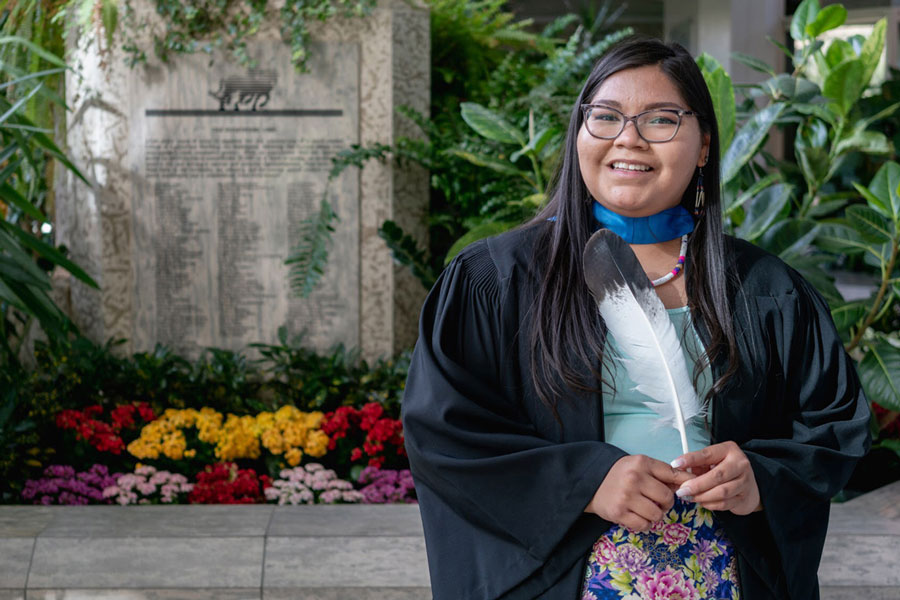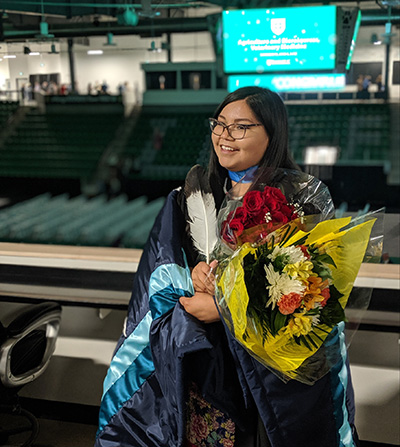
Embracing culture and science
How alumna Cree Autumn Sunrise Longjohn (BSCRRM'19) incorporates her heritage into her scientific work.
By ASHLEIGH MATTERNCree Autumn Sunrise Longjohn (wâhyaw kâ-itâpit | ᐋᐧᐦᔭᐤ ᑳ ᐃᑖᐱᐟ "forward seeing") says her Indigenous heritage has always guided her throughout her work. “I can’t think of any other way to do my work than having that incorporated,” she said.
Longjohn spent most of her childhood on Sturgeon Lake First Nation, and it was there that she was first introduced to the idea of studying the sciences at the postsecondary level. While she was in high school, she had an opportunity to participate in the Junior Forest Rangers program, which introduces Indigenous youth to natural resources science. She took part in an introductory summer program on soils, forestry and wildlife identification, and she was hooked.
“It got me interested in the natural resources side of science — that's what set me on this path,” she said.
Her path included enrolling in the Bachelor of Science in Renewable Resource Management degree through the College of Agriculture and Bioresources at the University of Saskatchewan (USask).
She has since graduated from the program, majoring in Resource Science, which provides skills in applied sciences and resource management for sustainable development projects like rejuvenating disturbed land or reducing greenhouse gas emissions from landscapes.
“One of the biggest motivators for me was being able to understand natural resources for my community so I can give back,” she said. “If I understood different resources, how they’re used, and how they’re taken care of, it’s something I can take back to my community.”
She said her favourite aspects of the Renewable Resource Management program were learning about natural resources and working with Indigenous communities.
“That whole connection to working with Indigenous folks … how to be that link between a stakeholder and Indigenous communities — those skills are important to learn.”
Longjohn also appreciated the collaborative nature of the program, saying she enjoyed working with a team of classmates on a capstone project for Mistawasis First Nation. The first nation had ideas for their land that they wanted Longjohn and her classmates to investigate. Longjohn and her classmates crafted a land use report using traditional knowledge to identify resources and locations that have been of traditional use and cultural significance to the Mistawasis First Nation on reserve lands, traditional territories and Treaty 6 territory.
“I really liked that aspect of being able to actually work with the folks at Mistawasis,” she said.
She found the professors and department heads at the College of AgBio to be personable, friendly, and easy to work with, and she encourages other students interested in taking a path similar to hers to get involved with the Environmental and Bioresources Students Association.
“I found studying with somebody else to be helpful in forming a sense of community,” she said. “Having a community … really helps the student experience overall.”
Longjohn is now coordinating science outreach to communities much like her own through the Science Outreach Office with the College of Arts & Science at USask.
In 2016, she started off as a science ambassador, spending time in northern Indigenous communities doing science activities with students. Then last year, she had the opportunity to be a student coordinator, coordinating programs with the communities that would be receiving students, and now she’s working as the interim science outreach manager, overseeing the coordinators and ambassadors by training them and providing support.
‘Other ways of teaching language’

Revitalizing Indigenous languages is another cause close to her heart, and something she tries to incorporate into her science outreach work.
One outreach program she has participated in is Kamskénow, which provides hands-on science and mathematics activities to Saskatoon classrooms with a high number of Indigenous students.
When helping to develop the cryptography session for the Kamskénow program, she incorporated the Cree language using the Cree star chart. The star chart is arranged in a non-linear star shape that displays the 44 syllabics and 14 consonants.
“The Cree star chart with the symbols that correlated with Roman orthology can be seen as a key,” she said. “The star chart is the way you can translate one to another, and the idea of cryptography is encrypting and decrypting.”
The similarities between cryptography and language translation stood out to her, and she saw how combining the two could be a unique way to incorporate the Cree language into the session.
Longjohn is in the process of completing an Indigenous language certificate out of the College of Education, which is aimed at giving students the tools and resources to teach the Cree language, going beyond the textbook.
“The textbook way is the western way,” she said. “There are other ways of teaching language that I’ve been learning the past two years.”
She is also close to completing a Bachelor of Science in biology with a minor in math.
Bringing two worlds together
Longjohn says she expects she’ll stay with science outreach for several more years, but she has big plans for her future, including starting her own culture camp, weaving together her scientific background with her Indigenous knowledge.
“It would be really great to harness those two worlds, and together to create something that’s different but relevant to Indigenous youth,” she said.
A culture camp is a place where you go to learn about different traditional skills or ways of knowing. She participated in a culture camp herself at Ministikwan Lake in northwest Saskatchewan called kâniyâsihk Culture Camps.
“It could look like hide tanning, learning how to identify medicinal plants or traditional medicines, learning about canoeing — land-based learning.”
She would also like to see elements of reclaiming language involved, incorporating language learning into the culture camps just as she did with the science outreach cryptography session.
“I’d like to see a culture camp like that in every Indigenous community.”
Originally published at https://agbio.usask.ca
Article re-posted on .
View original article.

